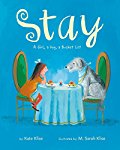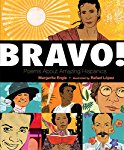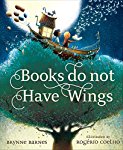A little over fourteen years ago I brought home a sick, miserable little bundle of fur. Pippin was a puppy mill rescue and he became one of my best friends. He went where I went, and loved me unconditionally, even when I was not at my best. He put up with sharing his home with a young child, a pig, and numerous cats and dogs. He even had to contend with grumpy docks patrolling his garden. He was love personified and his friendship mean a great deal to me. Knowing how precious such a friendship is, I decided to share this review with you. It perfectly captures how powerful the bond between a human and a dog can be.
Stay: A girl, a dog, a bucket list
Stay: A girl, a dog, a bucket list
Illustrated by M. Sarah Klise
Picture Book
For ages 5 to 7
Feiwel and Friends, 2017, 978-1-250-10714-5
From the moment Astrid was born Eli was a part of her
life. He was her first friend and he went on to become her bodyguard, her
favorite pillow, and her roommate. It did not matter in the least that Astrid
was a little girl and that Eli was a boy dog. They were besties.
Then Astrid
began to notice that she was getting bigger than her large furry friend. As she
was getting taller Eli was getting older, and by the time Astrid was six Eli
was an old dog who walked more slowly than he used to.
One day, when
they were in the park, Astrid shared her popcorn with Eli and then she took him
on the slide with her so that he could try it. When they got home she put
together a bucket list of all the things Eli should do before he was too old to
do them. She and Eli would go through the list.
Together the two
friends rode on a bike, they went to the library where they borrowed lots of books
that were about dogs, they went to a movie theatre, they slept outside, and
Astrid let Eli sleep under the covers in bed with her. Astrid even gave Eli a
bubble bath and brushed him for a whole hour afterwards. Astrid then added one
more thing to the list because she knew that her dear friend was slowing down.
Best friends are
precious things, and in this special book Kate Klise and M. Sarah Klise give us
a story that is a celebration of friendship. Their tale also serves as a
reminder that we should enjoy our time with loved ones to the fullest. As the
story unfolds, we get to see how the relationship between the child and the dog
changes over time. The child who was cared for is now the caregiver.








